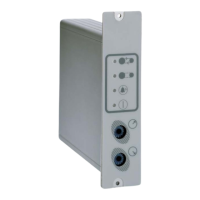© Edwards Limited 2010. All rights reserved. Page 33
Edwards and the Edwards logo are trademarks of Edwards Limited.
Operation
D397-50-880 Issue C
If master conditions are such that the controlled item should be off, an output data exchange value requesting the
controlled item should turn on will be ignored.
If master conditions are such that the controlled item should be on, an output data exchange value requesting the
controlled item should turn on or off will be followed - manual override. This allows, for example, a gauge to be
turned off before a rapid vent or before a gas feed is turned on that would contaminate the gauge if it were running.
Note: See Section 5.1, concern with TIC version D39700640C and earlier.
The TIC cancels a manual override when the master conditions alter such that the controlled item should change
state.
Controlling item (master object) - This is the item that will control the gauge.
Note: If an inappropriate choice is selected e.g. controlling gauge 1 with gauge 1 or controlling with turbo speed
when the TIC is an instrument only unit the TIC may appear to create a link but will not actually control
using the master object selected.
Units - The unit value must be a suitable type for the controlling item or the set-up will be ignored by the
TIC i.e. must use speed for a Turbo pump and must use pressure or volts for a gauge.
Setpoint On and Off - The setpoint value formats depend on the units selected. Both Pascal's and volts require an
IEEE-754 floating-point format number (32-bit). Use of IEEE-754 format to represent floating point numbers is
commonplace in PLCs. A useful conversion tool can be found at the following web address: http://
babbage.cs.qc.edu/courses/cs341/IEEE-754.html or at www.schmidt.net.
Percentage speed is a 16-bit integer with the number in 200th's of a percent i.e.50%=10,000(decimal)=2710(hex)
so number entered, for example in SyCon, should be 2710(00002710).
Enable - Enables or disables control at the chosen setpoint by the chosen master object. If this is set to "disabled"
the configured control link will not function.
4.8.18 Software module 913 - Gauge 1
This module can be used with any TIC version that includes gauges.
General Description
Control and monitoring of Gauge connected to gauge port number 1.
Output bytes (from Master)
Note: The value ’5’ (Degas) should be used with caution, It should not be used for any gauge type except AIGX.
With an AIGX the gauge should first be turned on (Value 1) then put into degas. After initiating degas the
value should be returned to 1 and degas will continue for the remainder of the 3 min period. If the value
is left at5, degas will be continuously used. If value is set to zero before degas is completed, the TIC will
no longer control the degas line correctly (version D397-00-640 Issue D and earlier).
Input bytes (to Master)
1st Gauge commands - refer to table in Appendix 4.
1st First four bytes form a 32-bit IEEE-754 format floating point
gauge value.
2nd
3rd
4th
5th Value units. (Pascals =59; volts =66). Taken from the gas type
parameterisation.
6th State - refer to table in Appendix A5.
7th Alert - refer to table in Appendix A2.
8th Priority - refer to table in Appendix A3.

